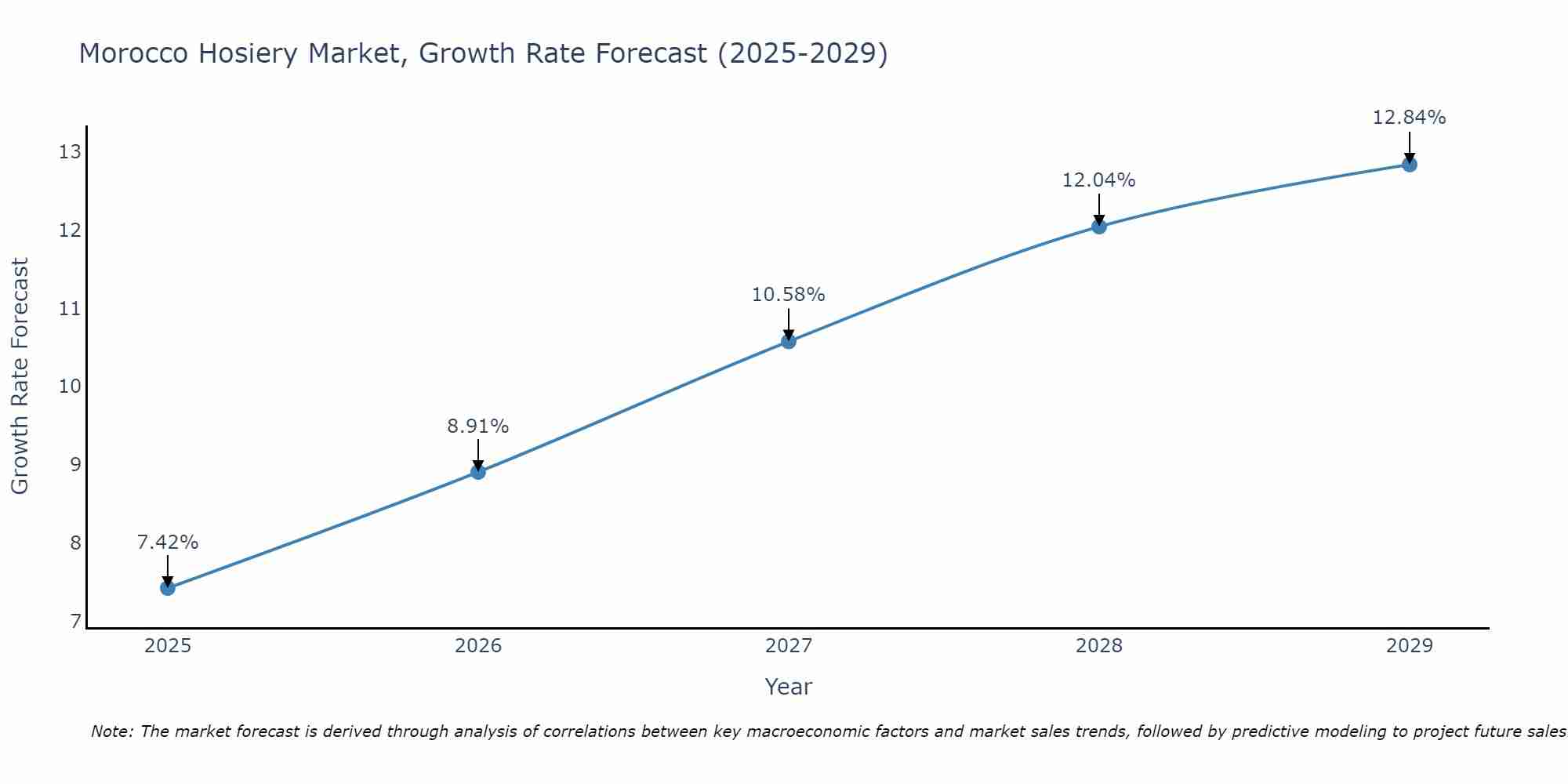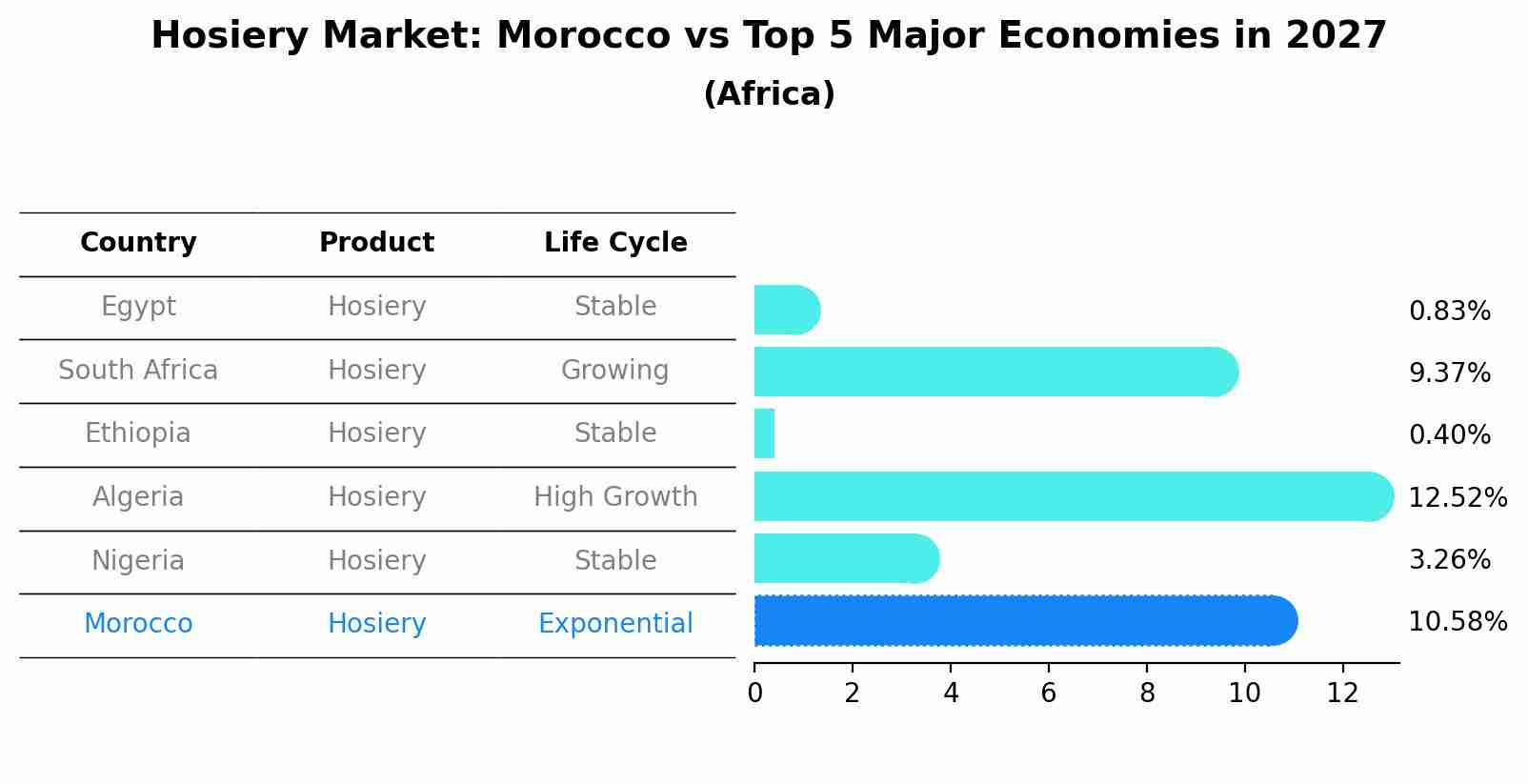Morocco Hosiery Market Outlook | Companies, Trends, Analysis, Industry, Size, COVID-19 IMPACT, Revenue, Share, Forecast, Growth & Value
| Product Code: ETC213425 | Publication Date: May 2022 | Updated Date: Aug 2025 | Product Type: Market Research Report | |
| Publisher: 6Wresearch | Author: Summon Dutta | No. of Pages: 60 | No. of Figures: 40 | No. of Tables: 7 |
Morocco Hosiery Market Size Growth Rate
The Morocco Hosiery Market is likely to experience consistent growth rate gains over the period 2025 to 2029. Commencing at 7.42% in 2025, growth builds up to 12.84% by 2029.

Hosiery Market: Morocco vs Top 5 Major Economies in 2027 (Africa)
Morocco's Hosiery market is anticipated to experience a high growth rate of 10.58% by 2027, reflecting trends observed in the largest economy Egypt, followed by South Africa, Ethiopia, Algeria and Nigeria.

Morocco Hosiery Market Overview
The Morocco hosiery market is experiencing steady growth driven by increasing consumer demand for fashionable and comfortable legwear. With a rising awareness of the latest fashion trends and the influence of global fashion brands, Moroccan consumers are showing a growing interest in hosiery products. The market offers a wide range of hosiery products, including socks, stockings, tights, and leggings, catering to different consumer preferences. Domestic manufacturers and international brands both play a significant role in shaping the market dynamics, with a focus on product innovation and quality. As the Moroccan economy continues to strengthen and consumer purchasing power increases, the hosiery market is expected to further expand, offering opportunities for both local and international hosiery manufacturers and retailers.
Morocco Hosiery Market Trends
The hosiery market in Morocco is experiencing a shift towards more sustainable and eco-friendly products, driven by increasing consumer awareness of environmental issues. There is a growing demand for organic and ethically sourced materials in hosiery, with a focus on comfort and durability. Additionally, there is a rising preference for trendy and fashionable hosiery styles that can be worn for both casual and formal occasions. Moroccan consumers are also showing interest in innovative technologies that enhance the performance and quality of hosiery products, such as moisture-wicking fabrics and seamless designs. E-commerce platforms are playing a significant role in the market, providing consumers with a convenient way to shop for a wide range of hosiery products from both local and international brands.
Morocco Hosiery Market Challenges
In the Morocco Hosiery Market, some challenges include increasing competition from international brands, fluctuating raw material prices, and limited domestic production capacity. International brands often have more resources for marketing and distribution, posing a challenge for local hosiery companies to compete. Fluctuating raw material prices, such as cotton and synthetic fibers, can impact production costs and profit margins. Additionally, the limited domestic production capacity in Morocco may lead to supply chain issues and reliance on imports. To address these challenges, hosiery companies in Morocco need to focus on enhancing their branding and marketing strategies, establishing stable supply chains for raw materials, and investing in expanding local production capabilities.
Morocco Hosiery Market Investment Opportunities
The Morocco hosiery market presents various investment opportunities for both domestic and international investors. With the increasing demand for fashionable and comfortable hosiery products among Moroccan consumers, there is a growing market for innovative and high-quality hosiery items such as socks, stockings, and tights. Investing in the manufacturing and distribution of eco-friendly and sustainable hosiery products could tap into the rising trend of conscious consumerism in the country. Additionally, expanding into the online retail sector could leverage the growing e-commerce market in Morocco, providing a convenient platform for consumers to purchase hosiery products. Collaborating with local designers and influencers to create unique and culturally relevant hosiery collections could also attract a niche market segment and drive sales in the Morocco hosiery market.
Morocco Hosiery Market Government Policy
Government policies related to the Morocco Hosiery Market primarily involve trade regulations, import/export duties, and labor laws. The Moroccan government has implemented policies to support domestic hosiery producers by imposing tariffs and quotas on imported hosiery products to protect local industries. Additionally, there are regulations on quality standards and labeling requirements to ensure consumer safety and fair competition in the market. Labor laws play a significant role in regulating working conditions and wages for hosiery industry workers, aiming to protect their rights and ensure fair labor practices. Overall, government policies in Morocco aim to support the growth of the domestic hosiery market while maintaining a balance between protecting local industries and promoting fair trade practices.
Morocco Hosiery Market Future Outlook
The future outlook for the Morocco Hosiery Market appears promising, driven by factors such as increasing disposable income, changing fashion trends, and a growing awareness of personal grooming. With a rising young population, there is a growing demand for a variety of hosiery products, including socks, stockings, and tights. Furthermore, the increasing penetration of e-commerce platforms is expected to boost the market`s accessibility and reach to a wider consumer base. Manufacturers are also focusing on product innovation, including sustainable and eco-friendly materials, to cater to the evolving preferences of the environmentally conscious consumers. Overall, the Morocco Hosiery Market is poised for steady growth in the coming years, offering opportunities for both domestic and international hosiery brands to expand their presence in the region.
Key Highlights of the Report:
- Morocco Hosiery Market Outlook
- Market Size of Morocco Hosiery Market, 2021
- Forecast of Morocco Hosiery Market, 2031
- Historical Data and Forecast of Morocco Hosiery Revenues & Volume for the Period 2018 - 2031
- Morocco Hosiery Market Trend Evolution
- Morocco Hosiery Market Drivers and Challenges
- Morocco Hosiery Price Trends
- Morocco Hosiery Porter's Five Forces
- Morocco Hosiery Industry Life Cycle
- Historical Data and Forecast of Morocco Hosiery Market Revenues & Volume By End-User for the Period 2018 - 2031
- Historical Data and Forecast of Morocco Hosiery Market Revenues & Volume By Men for the Period 2018 - 2031
- Historical Data and Forecast of Morocco Hosiery Market Revenues & Volume By Women for the Period 2018 - 2031
- Historical Data and Forecast of Morocco Hosiery Market Revenues & Volume By Distribution Channel for the Period 2018 - 2031
- Historical Data and Forecast of Morocco Hosiery Market Revenues & Volume By Offline for the Period 2018 - 2031
- Historical Data and Forecast of Morocco Hosiery Market Revenues & Volume By Online for the Period 2018 - 2031
- Morocco Hosiery Import Export Trade Statistics
- Market Opportunity Assessment By End-User
- Market Opportunity Assessment By Distribution Channel
- Morocco Hosiery Top Companies Market Share
- Morocco Hosiery Competitive Benchmarking By Technical and Operational Parameters
- Morocco Hosiery Company Profiles
- Morocco Hosiery Key Strategic Recommendations
Frequently Asked Questions About the Market Study (FAQs):
1 Executive Summary |
2 Introduction |
2.1 Key Highlights of the Report |
2.2 Report Description |
2.3 Market Scope & Segmentation |
2.4 Research Methodology |
2.5 Assumptions |
3 Morocco Hosiery Market Overview |
3.1 Morocco Country Macro Economic Indicators |
3.2 Morocco Hosiery Market Revenues & Volume, 2021 & 2031F |
3.3 Morocco Hosiery Market - Industry Life Cycle |
3.4 Morocco Hosiery Market - Porter's Five Forces |
3.5 Morocco Hosiery Market Revenues & Volume Share, By End-User, 2021 & 2031F |
3.6 Morocco Hosiery Market Revenues & Volume Share, By Distribution Channel, 2021 & 2031F |
4 Morocco Hosiery Market Dynamics |
4.1 Impact Analysis |
4.2 Market Drivers |
4.2.1 Increasing disposable income among Moroccan consumers |
4.2.2 Growing awareness about fashion trends and personal grooming |
4.2.3 Expansion of retail distribution channels for hosiery products |
4.3 Market Restraints |
4.3.1 Seasonal demand fluctuations due to weather conditions |
4.3.2 Competition from substitute products like leggings and tights |
4.3.3 Impact of economic uncertainties on consumer spending behavior |
5 Morocco Hosiery Market Trends |
6 Morocco Hosiery Market, By Types |
6.1 Morocco Hosiery Market, By End-User |
6.1.1 Overview and Analysis |
6.1.2 Morocco Hosiery Market Revenues & Volume, By End-User, 2021-2031F |
6.1.3 Morocco Hosiery Market Revenues & Volume, By Men, 2021-2031F |
6.1.4 Morocco Hosiery Market Revenues & Volume, By Women, 2021-2031F |
6.2 Morocco Hosiery Market, By Distribution Channel |
6.2.1 Overview and Analysis |
6.2.2 Morocco Hosiery Market Revenues & Volume, By Offline, 2021-2031F |
6.2.3 Morocco Hosiery Market Revenues & Volume, By Online, 2021-2031F |
7 Morocco Hosiery Market Import-Export Trade Statistics |
7.1 Morocco Hosiery Market Export to Major Countries |
7.2 Morocco Hosiery Market Imports from Major Countries |
8 Morocco Hosiery Market Key Performance Indicators |
8.1 Average selling price of hosiery products |
8.2 Percentage of online sales in the hosiery market |
8.3 Number of new product launches in the market |
9 Morocco Hosiery Market - Opportunity Assessment |
9.1 Morocco Hosiery Market Opportunity Assessment, By End-User, 2021 & 2031F |
9.2 Morocco Hosiery Market Opportunity Assessment, By Distribution Channel, 2021 & 2031F |
10 Morocco Hosiery Market - Competitive Landscape |
10.1 Morocco Hosiery Market Revenue Share, By Companies, 2021 |
10.2 Morocco Hosiery Market Competitive Benchmarking, By Operating and Technical Parameters |
11 Company Profiles |
12 Recommendations |
13 Disclaimer |
- Single User License$ 1,995
- Department License$ 2,400
- Site License$ 3,120
- Global License$ 3,795
Search
Thought Leadership and Analyst Meet
Our Clients
Related Reports
- Germany Breakfast Food Market (2026-2032) | Industry, Share, Growth, Size, Companies, Value, Analysis, Revenue, Trends, Forecast & Outlook
- Australia Briquette Market (2025-2031) | Growth, Size, Revenue, Forecast, Analysis, Trends, Value, Share, Industry & Companies
- Vietnam System Integrator Market (2025-2031) | Size, Companies, Analysis, Industry, Value, Forecast, Growth, Trends, Revenue & Share
- ASEAN and Thailand Brain Health Supplements Market (2025-2031) | Strategy, Consumer Insights, Analysis, Investment Trends, Opportunities, Growth, Size, Share, Industry, Revenue, Segments, Value, Segmentation, Supply, Forecast, Restraints, Outlook, Competition, Drivers, Trends, Demand, Pricing Analysis, Competitive, Strategic Insights, Companies, Challenges
- ASEAN Bearings Market (2025-2031) | Strategy, Consumer Insights, Analysis, Investment Trends, Opportunities, Growth, Size, Share, Industry, Revenue, Segments, Value, Segmentation, Supply, Forecast, Restraints, Outlook, Competition, Drivers, Trends, Demand, Pricing Analysis, Competitive, Strategic Insights, Companies, Challenges
- Europe Flooring Market (2025-2031) | Outlook, Share, Industry, Trends, Forecast, Companies, Revenue, Size, Analysis, Growth & Value
- Saudi Arabia Manlift Market (2025-2031) | Outlook, Size, Growth, Trends, Companies, Industry, Revenue, Value, Share, Forecast & Analysis
- Uganda Excavator, Crane, and Wheel Loaders Market (2025-2031) | Strategy, Consumer Insights, Analysis, Investment Trends, Opportunities, Growth, Size, Share, Industry, Revenue, Segments, Value, Segmentation, Supply, Forecast, Restraints, Outlook, Competition, Drivers, Trends, Demand, Pricing Analysis, Competitive, Strategic Insights, Companies, Challenges
- Rwanda Excavator, Crane, and Wheel Loaders Market (2025-2031) | Strategy, Consumer Insights, Analysis, Investment Trends, Opportunities, Growth, Size, Share, Industry, Revenue, Segments, Value, Segmentation, Supply, Forecast, Restraints, Outlook, Competition, Drivers, Trends, Demand, Pricing Analysis, Competitive, Strategic Insights, Companies, Challenges
- Kenya Excavator, Crane, and Wheel Loaders Market (2025-2031) | Strategy, Consumer Insights, Analysis, Investment Trends, Opportunities, Growth, Size, Share, Industry, Revenue, Segments, Value, Segmentation, Supply, Forecast, Restraints, Outlook, Competition, Drivers, Trends, Demand, Pricing Analysis, Competitive, Strategic Insights, Companies, Challenges
Industry Events and Analyst Meet
Whitepaper
- Middle East & Africa Commercial Security Market Click here to view more.
- Middle East & Africa Fire Safety Systems & Equipment Market Click here to view more.
- GCC Drone Market Click here to view more.
- Middle East Lighting Fixture Market Click here to view more.
- GCC Physical & Perimeter Security Market Click here to view more.
6WResearch In News
- Doha a strategic location for EV manufacturing hub: IPA Qatar
- Demand for luxury TVs surging in the GCC, says Samsung
- Empowering Growth: The Thriving Journey of Bangladesh’s Cable Industry
- Demand for luxury TVs surging in the GCC, says Samsung
- Video call with a traditional healer? Once unthinkable, it’s now common in South Africa
- Intelligent Buildings To Smooth GCC’s Path To Net Zero


















